1945 V-DAY Royal Circle Athletic Schaerbeek Equestrian Horse Belgium medal Award
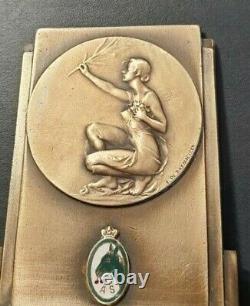
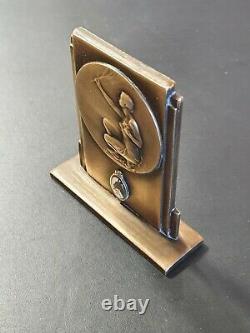
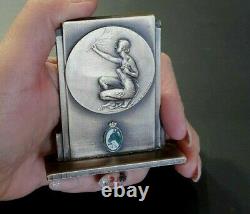
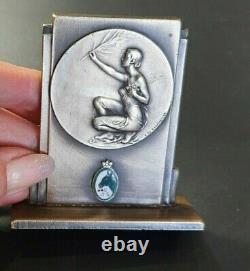
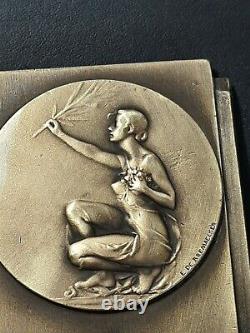
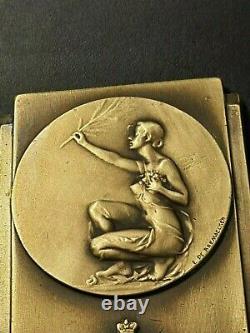
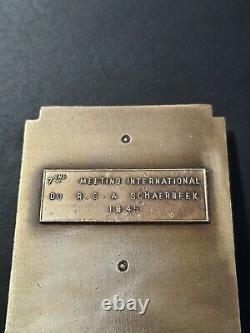
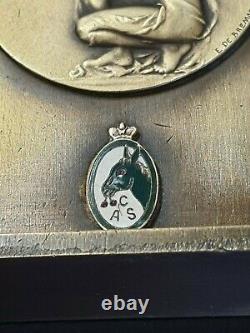
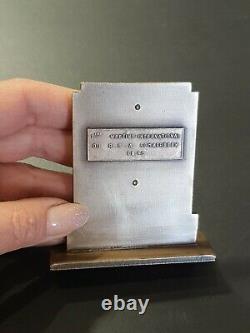

Eugène Jean de Bremaecker is a Belgian. A pupil of Victor Rousseau. He is the author of numerous works both in Belgium and abroad. Official statuary and original creations.
A rich and varied work. He started early if we are to believe his words. At five years old, I was already a budding sculptor! I modeled God knows how! Despite these dispositions of my young age, my father wanted me to enter the Academy of Saint-Josse.
And after a month I was doing sculpture! I then went to the Academy of Brussels. On the advice of Master Dillens.
The following year, I was received at the Salon de Bruxelles. He is a pupil of Victor Rousseau. But he also studies other great masters on his own, he explains. But, when you leave the Academy, what do you know?
You have to learn the trade. The study of ancient and modern is self-evident. I devoted myself to their study.
I especially liked Carpeaux, the most beautiful of sculptors. I spent hours, weeks, months at the Louvre, to such an extent that the guards referred to me by the pretty name of Le Maniaque. Little by little, I became convinced, I worked. Eugène de Bremaecker visits trade fairs and exhibitions, knows the works of his contemporaries such as Jef Lambeaux. He is very sensitive to the tradition of Belgian culture, including the many creators from the north of the country. It is placed in pivotal position in the. Century from which it takes its way of working naturalist and particularly expressive, and the first half of the. Century and he made the most significant part of his work. He thus builds a bridge between two eras over the ditch of the Great War. In addition to his artistic activity, he took an early interest in photography. Barely a dozen years old, he took pictures on Heyst.Who spoke to him to encourage him in this direction. He took many photographs during World War I. He also worked on improving wireless telegraphy. The Journal d'Anvers of March 30, 1928, under the title Nos sculpteurs Eugène de Bremaecker writes.
If the sculptor does not always have an easy task, he at least - when he fully possesses his profession - the great satisfaction of producing a work that one appreciates and that one admires. The work of Eugene de Bremaecker is one of which imposes itself in silence, and which one appreciates with emotion. De Bremaecker working on the statue of the tomb of the Cauderlier family in 1911. Speaking of the Paris salons on May 23, 1926, the Neptune of Antwerp said. The bust of Cardinal Mercier is one of Eugène de Bremaecker's best productions; the torso is draped in the picturesque fashion of seventeenth-century French effigies, ...
Which highlights the life breathed by the bony and voluntary mask of the ascetic prelate. The journal of Bruges and the province was certainly not stingy with compliments when Pierre Huybrechts said in his edition of March 25-26, 1928. We bow with respect to this brilliant talent and art understands why de Bremaecker has deserved the favors of the great of the earth, and enjoys a worldwide reputation. We can point out that Eugène de Bremaecker will regularly have the honor of columns in newspapers such as the Last Hour , the Belgian Nation or Le Soir for Belgium, and Le Temps. France will be attentive to its creations, in the Journal de la Seine on May 18, 1930, we can read from the pen of Albert Parenty. At the Salon Annuel held at the Grand Palais. The sculpture section is particularly well represented this year. Have sent works worthy of attention... De Bremaecker, Neuilly, Malice , jolie tête and Par un beau matin , joli bust. We can also read, on December 10, 1926, in Homme libre an article by René Barotte, under the title The great modern artists Eugène-Jean de Bremaecker statuaire. A few days ago, I visited Eugène de Bremaecker, a well-known sculptor who shares his creative activity between his workshops in Neuilly and Brussels. Of his compatriots, our great friends the Belgians, de Bremaecker possesses the apparent placidity, at least for those who know him little, discuss a subject of everyday life. But as soon as you talk to him about his art as soon as he has felt a spiritual friend in you, his face blossoms, his gaze takes on a particular radiance, ardor wins, he becomes lyrical without ever departing from limpidity. Of language he uses to show you a powerful and luminous aesthetic. While, joining the action to the word, working the block with the finger like a roughing. To bring it to life he revealed to me the secrets of his art, quickly the hours passed, too quickly I had to leave...Regretfully, of course, but happy to have met an artist there are few in our time! Whose talent was at the height of thought. It is not only in the press of Belgium and France that one speaks about his work thus, in the New York Herald.
Of April 19, 1927, under the title Art Paris Notes in an article signed by George Bal. An exposition was opened on Friday at Trotti Galleris, place Vendôme, of the works of Eugène de Bremaecker, a Belgian sculptor, who, by numerous busts of well-know persons and and by his imaginative figures, proves that he is an artist, of greattalent. I noted at once bust of Prince Léopold of Belgium and those of Cardinal Mercier, Baron Gaiffier d'Hestoy, Belgian Ambassador in Paris, and many other political personalities which indicate wath a great knowledge of the art of portraiture their author possesses. As for the varied works of this artist they are those of Amfortas from "Parsifal", full of an expression of human grieso intense and profound. This important figure was executed from sittings by M.
I also noticed an interesting "Salomé", in bronze and "Méditation". The same year, February 17, 1927, Eugene J. Bremaecker made the cover of Figaro Art with Cardinal Mercier bust offered at the Institut de France on the occasion of the reception of His Majesty King Albert. Of Belgium, December 18, 1926. He is best known today for his official busts and dancers. The official bust of the King of Belgium Albert. Seen for example at the Bellevue museum Place des Palais in Brussels, or dancers. It is therefore not surprising that he was recognized very early on by the European intelligentsia, he made among others, the medal of King Edward VIII. At that time he was appointed a corresponding member of the Royal Society of Arts in London. In 1903, he received an order from the Belgian State for a 5.50. Exhibition in the United States. He also sculpts the official bust of King Albert. We owe him a bust of Prince Leopold, future King Leopold III.Executed in 1922 at the Palace of Brussels. It also models the bust of Queen Astrid. Count of Flanders is regent comes to ask her workshop in Brussels.
He has, moreover, the order by the Queen Elizabeth Fund for Medical Assistance to the Indians of the Belgian Congo of a bas-relief which is also struck as a medal. He made the bust of Cardinal Mercier. Modeled after the archbishopric of Mechelen. Belgian statesman, with whom he maintains a correspondence, or of the mayor of Brussels, Adolphe Max. His work thus includes no less than two hundred and fifty busts, including the busts of Maurice Maeterlinck. In the aftermath of the First World War, de Bremaecker contributed to the creation of the numerous monuments which honor the memory of the dead and of the heroes who distinguished themselves during these four terrible years. We owe him in Brussels, the bust of the monument of General Dossin.Near the abbey of La Cambre; for the town of Lobbes. The monument for the war dead; and still others in Ypres. Where he displayed the greatest talent as a creative artist, it was by making his statues and statuettes of dancers.
Let us quote Vers la Joie or La Danseuse aux cymbales. They earned him a commission from the French Republic for the Jeu de Paume museum. Now in the collections of the Center Georges Pompidou. The presentation of dancers statues, statuettes or bas-relief immediately aroused the enthusiasm of critics but also of all these contemporaries.
Through his statues he pays homage to "the eternal feminine" which will be the title of one of his works. Breaking with women a little heavy, carved in the. Century, it prefers flowing lines, with disorderly movements or entangled, the air through the body by moving hanging in the perfection of the moment, the boundary between the real and the'imaginary.This refusal to submit to the dictates of a fashion that often came from outside the borders, earned it a place apart. Bremaecker's works are part of the landscape of Belgian cities. It produces For example the relief monumental, Queen Elisabeth of Belgium's nursing a wounded to the monument of King Albert.
In Brussels, they are found both at the Museum of Central Africa (Tervuren): Slave and at the Army Museum: bas-reliefs of generals in the city itself: monument to gendarmes killed in command, Puccini memorial, or still in the churches like a wooden Virgin (life size) in the church of the abbey of La Cambre and the church of the Faisanderie (in Stockel). He will always keep excellent relations with the archbishopric of Mechelen, which played an important role in these orders. In Paris, his works, some of which have already been cited, entered both the Institut de France. (bust of Cardinal Mercier), and the Opéra Félia Litvine, at the Jeu de Paume museum, at the Hôtel-Dieu in Paris (bust of Queen Astrid) or at St.
Contrary to what a too rapid approach to this very abundant work might lead one to believe, the Second World War. Did not put a stop to his creative activity.
In 1952, he produced the group Peleas et Mélisande inspired by the scene of the well, today in the corridors of the Municipal House of Schaerbeek. Where he spent the last years of his life. In a completely different genre, he makes wooden statues presenting the men of the building trades. They are now visible near the Grand'Place in Brussels.
Thus, until his last days Eugène de Bremaecker lived, for the art in which he believed, to which he devoted all his passion and his enthusiasm. After having had workshops in the Paris region Neuilly. Rue Jacques Dulud and in Brussels avenue Longchamp, today avenue Winston Churchill.
, he spent the last years of his life in Schaerbeek. Where he had his workshop. He died on January 18, 1963 at the hospital in Ixelles.The places where the works are located, are unless otherwise stated, those where they were placed after their execution. Palais Mazarin, bust of Cardinal Mercier. At the Institut de France.
Opera Museum (Paris): high relief of Félia Litvine. Paris, Hôtel Dieu: bust of Queen Astrid of Belgium. Paris, Saint-Louis Hospital: bas-relief of Doctor Auseiberg.Monument to the Gendarmerie Ixelles. Monument to General Dossin in the park of the Abbey of La Cambre. Memorial - marble bust of Puccini.
At the Royal Theater of La Monnaie. Cauderlier monument in the Ixelles cemetery. In wood at the Abbey of La Cambre. In the choir of the church of La Cambre. Virgin and Child in stone in the choir of the Faisanderie church in Stockel.
Two wooden statues: the architect and the mason in the entrance hall of twelve rue de l'Étuve (visible from the outside). At the Royal Museum for Central Africa.Koninklijk Museum voor Midden-Afrika : Slave , work in ivory. Marble busts of King Albert.
Palace of the Province of Antwerp. Medal commemorating the 1914 - 1918 war awarded to all mobilized or volunteered soldiers. Combatant war volunteer medal, reserved for volunteers who have fought.
This item is in the category "Coins & Paper Money\Exonumia\Medals". The seller is "top-art-medals" and is located in this country: IL. This item can be shipped worldwide.
